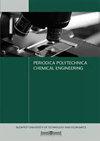六方氮化硼纳米片增强聚丙烯纳米复合薄膜的制备与表征
IF 1.8
4区 工程技术
Q3 ENGINEERING, CHEMICAL
引用次数: 0
摘要
在本研究中,我们采用熔融氢氧化物剥离法合成了六方氮化硼纳米片(h-BNN),得到了小薄片和纳米卷。得到的h- bnn可以分散在各种溶剂中,如水、乙醇和丙酮,并形成稳定的分散体。利用傅里叶变换红外光谱(FTIR)、x射线衍射(XRD)和扫描电镜(SEM)对h-BNNs进行了形态和结构分析。采用母粒(MB)法将h-BNNs通过熔融混合掺入聚丙烯(PP)基体中。稀释和薄膜生产过程使用双螺杆挤出机进行。制备了h-BNN重量比分别为1%、2%、3%和5%的纳米复合膜。采用热重分析仪(TGA)和差示扫描量热仪(DSC)对其热稳定性进行了研究。结晶温度(Tc)随h-BNNs用量的增加而升高,并观察到h-BNNs成核剂对PP结晶的影响。纯PP的氧化诱导时间(OIT)从8.84 min增加到17.82 min。结果表明,h-BNN含量对所研究的纳米复合材料的热氧化稳定性有相当大的影响。PP-hBNN纳米复合膜的流变学和力学性能也随颗粒负载比的变化而变化。最佳颗粒含量提供最佳的热,机械和流变性能被发现是3%重量。本文章由计算机程序翻译,如有差异,请以英文原文为准。
Processing and Characterization of Polypropylene Nanocomposite Films Reinforced with Hexagonal Boron Nitride Nanosheets
In this study, we synthesized hexagonal boron nitride nanosheets (h-BNN) via the molten hydroxide exfoliation method which results in small flakes and nanoscrolls. The resultant h-BNNs can be dispersed in various solvents such as water, ethanol, and acetone, and form a stable dispersion. The morphological and structural analysis of h-BNNs were performed with Fourier Transform infrared spectroscopy (FTIR), X-ray diffractometry (XRD), and scanning electron microscopy (SEM). The masterbatch (MB) method was used to incorporate the h-BNNs into the polypropylene (PP) matrix via melt mixing. Dilution and film production processes were performed using a twin screw extruder. Nanocomposite films having an h-BNN weight ratio of 1%, 2%, 3%, and 5% were prepared. Thermogravimetric analyzer (TGA) and differential scanning calorimetry (DSC) were used to investigate the thermal stability. Crystallization (Tc) temperatures were increased with the increased amount of h-BNNs and h-BNNs nucleating agent behavior on the PP crystallization was observed. Oxidation induction time (OIT) of the pure PP was increased from 8.84 min to 17.82 min. The results show a considerable effect of the h-BNN content on the thermo-oxidative stability of the nanocomposites studied. The rheological and mechanical properties of the PP-hBNN nanocomposite films were also determined depending on the particle loading ratio. Optimum particle content providing the best thermal, mechanical, and rheological properties were found to be 3% wt.
求助全文
通过发布文献求助,成功后即可免费获取论文全文。
去求助
来源期刊

Periodica Polytechnica Chemical Engineering
ENGINEERING, CHEMICAL-
CiteScore
3.10
自引率
7.70%
发文量
44
审稿时长
>12 weeks
期刊介绍:
The main scope of the journal is to publish original research articles in the wide field of chemical engineering including environmental and bioengineering.
 求助内容:
求助内容: 应助结果提醒方式:
应助结果提醒方式:


